HUMMER H3 2009 Owners Manual
Manufacturer: HUMMER, Model Year: 2009, Model line: H3, Model: HUMMER H3 2009Pages: 382, PDF Size: 1.99 MB
Page 231 of 382
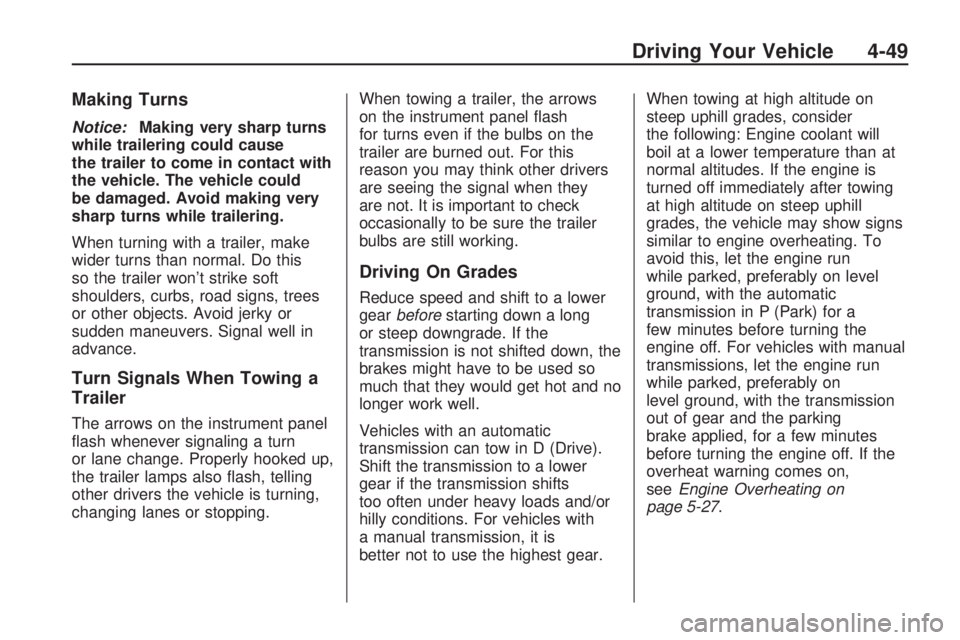
Making Turns
Notice:Making very sharp turns
while trailering could cause
the trailer to come in contact with
the vehicle. The vehicle could
be damaged. Avoid making very
sharp turns while trailering.
When turning with a trailer, make
wider turns than normal. Do this
so the trailer won’t strike soft
shoulders, curbs, road signs, trees
or other objects. Avoid jerky or
sudden maneuvers. Signal well in
advance.
Turn Signals When Towing a
Trailer
The arrows on the instrument panel
�ash whenever signaling a turn
or lane change. Properly hooked up,
the trailer lamps also �ash, telling
other drivers the vehicle is turning,
changing lanes or stopping.When towing a trailer, the arrows
on the instrument panel �ash
for turns even if the bulbs on the
trailer are burned out. For this
reason you may think other drivers
are seeing the signal when they
are not. It is important to check
occasionally to be sure the trailer
bulbs are still working.
Driving On Grades
Reduce speed and shift to a lower
gearbeforestarting down a long
or steep downgrade. If the
transmission is not shifted down, the
brakes might have to be used so
much that they would get hot and no
longer work well.
Vehicles with an automatic
transmission can tow in D (Drive).
Shift the transmission to a lower
gear if the transmission shifts
too often under heavy loads and/or
hilly conditions. For vehicles with
a manual transmission, it is
better not to use the highest gear.When towing at high altitude on
steep uphill grades, consider
the following: Engine coolant will
boil at a lower temperature than at
normal altitudes. If the engine is
turned off immediately after towing
at high altitude on steep uphill
grades, the vehicle may show signs
similar to engine overheating. To
avoid this, let the engine run
while parked, preferably on level
ground, with the automatic
transmission in P (Park) for a
few minutes before turning the
engine off. For vehicles with manual
transmissions, let the engine run
while parked, preferably on
level ground, with the transmission
out of gear and the parking
brake applied, for a few minutes
before turning the engine off. If the
overheat warning comes on,
seeEngine Overheating on
page 5-27.
Driving Your Vehicle 4-49
Page 232 of 382
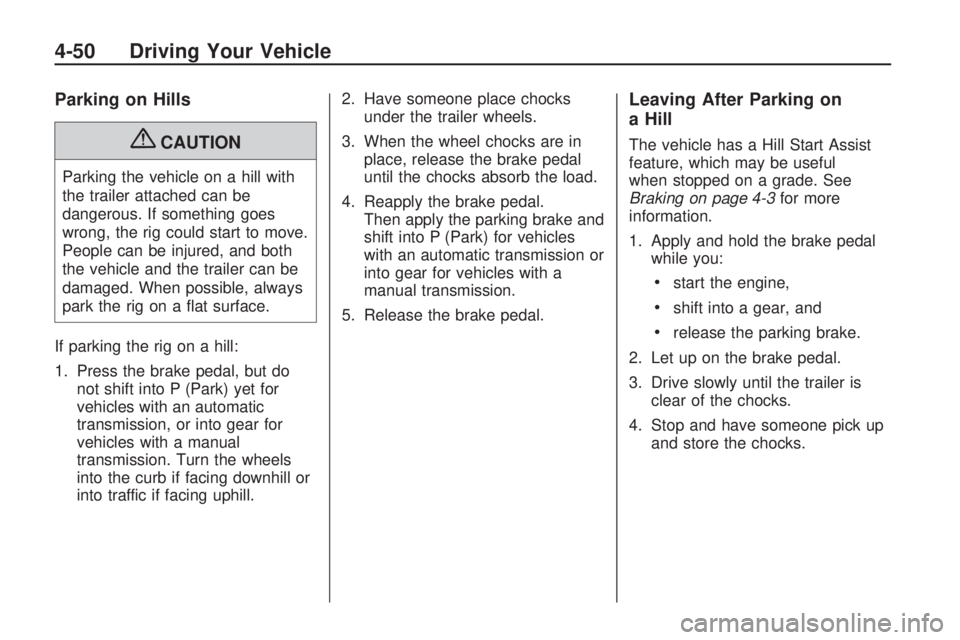
Parking on Hills
{CAUTION
Parking the vehicle on a hill with
the trailer attached can be
dangerous. If something goes
wrong, the rig could start to move.
People can be injured, and both
the vehicle and the trailer can be
damaged. When possible, always
park the rig on a �at surface.
If parking the rig on a hill:
1. Press the brake pedal, but do
not shift into P (Park) yet for
vehicles with an automatic
transmission, or into gear for
vehicles with a manual
transmission. Turn the wheels
into the curb if facing downhill or
into traffic if facing uphill.2. Have someone place chocks
under the trailer wheels.
3. When the wheel chocks are in
place, release the brake pedal
until the chocks absorb the load.
4. Reapply the brake pedal.
Then apply the parking brake and
shift into P (Park) for vehicles
with an automatic transmission or
into gear for vehicles with a
manual transmission.
5. Release the brake pedal.
Leaving After Parking on
a Hill
The vehicle has a Hill Start Assist
feature, which may be useful
when stopped on a grade. See
Braking on page 4-3for more
information.
1. Apply and hold the brake pedal
while you:
start the engine,
shift into a gear, and
release the parking brake.
2. Let up on the brake pedal.
3. Drive slowly until the trailer is
clear of the chocks.
4. Stop and have someone pick up
and store the chocks.
4-50 Driving Your Vehicle
Page 233 of 382
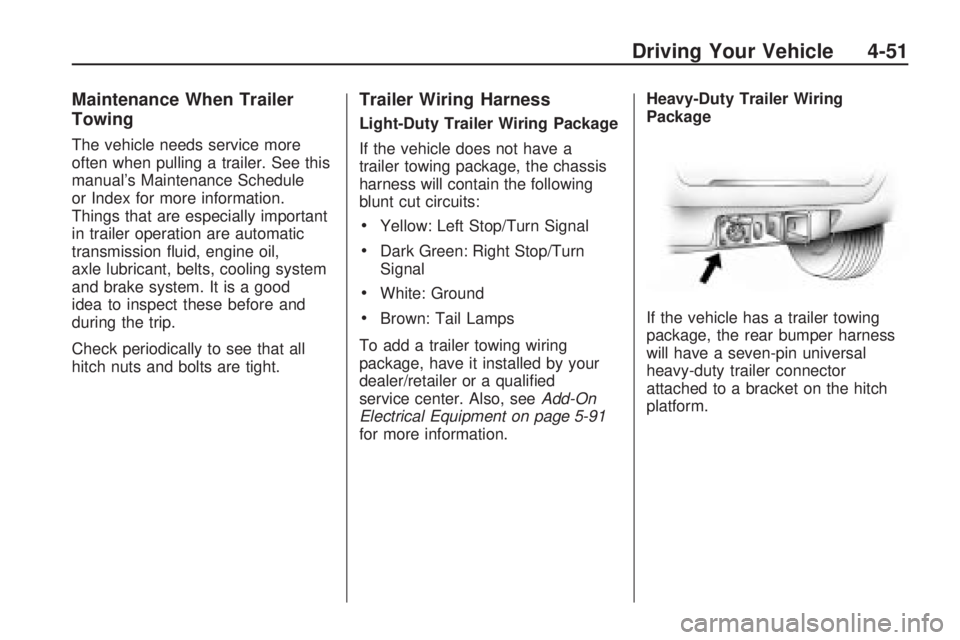
Maintenance When Trailer
Towing
The vehicle needs service more
often when pulling a trailer. See this
manual’s Maintenance Schedule
or Index for more information.
Things that are especially important
in trailer operation are automatic
transmission �uid, engine oil,
axle lubricant, belts, cooling system
and brake system. It is a good
idea to inspect these before and
during the trip.
Check periodically to see that all
hitch nuts and bolts are tight.
Trailer Wiring Harness
Light-Duty Trailer Wiring Package
If the vehicle does not have a
trailer towing package, the chassis
harness will contain the following
blunt cut circuits:
Yellow: Left Stop/Turn Signal
Dark Green: Right Stop/Turn
Signal
White: Ground
Brown: Tail Lamps
To add a trailer towing wiring
package, have it installed by your
dealer/retailer or a quali�ed
service center. Also, seeAdd-On
Electrical Equipment on page 5-91
for more information.Heavy-Duty Trailer Wiring
Package
If the vehicle has a trailer towing
package, the rear bumper harness
will have a seven-pin universal
heavy-duty trailer connector
attached to a bracket on the hitch
platform.
Driving Your Vehicle 4-51
Page 234 of 382
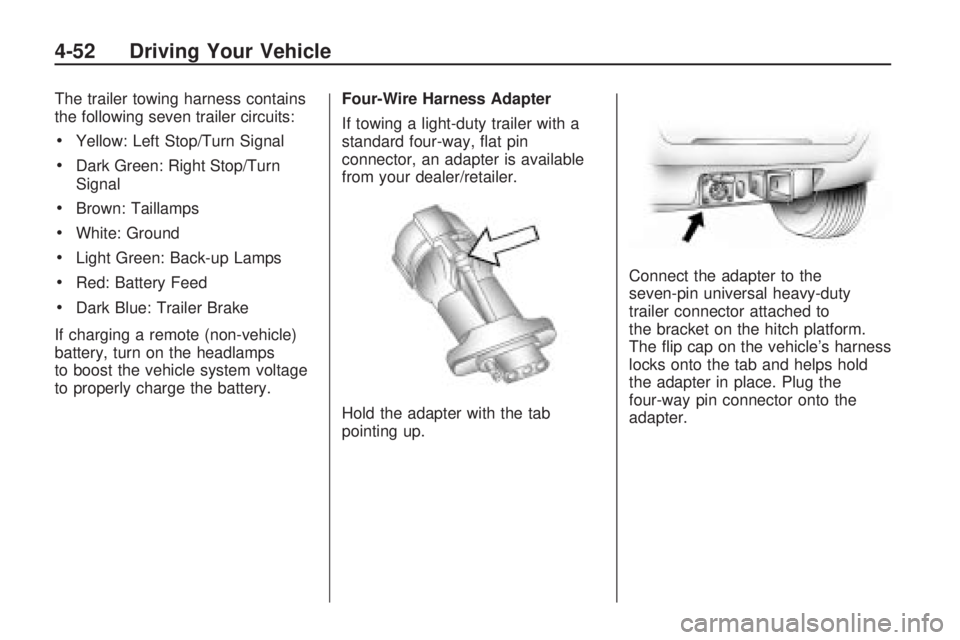
The trailer towing harness contains
the following seven trailer circuits:
Yellow: Left Stop/Turn Signal
Dark Green: Right Stop/Turn
Signal
Brown: Taillamps
White: Ground
Light Green: Back-up Lamps
Red: Battery Feed
Dark Blue: Trailer Brake
If charging a remote (non-vehicle)
battery, turn on the headlamps
to boost the vehicle system voltage
to properly charge the battery.Four-Wire Harness Adapter
If towing a light-duty trailer with a
standard four-way, �at pin
connector, an adapter is available
from your dealer/retailer.
Hold the adapter with the tab
pointing up.Connect the adapter to the
seven-pin universal heavy-duty
trailer connector attached to
the bracket on the hitch platform.
The �ip cap on the vehicle’s harness
locks onto the tab and helps hold
the adapter in place. Plug the
four-way pin connector onto the
adapter.
4-52 Driving Your Vehicle
Page 235 of 382
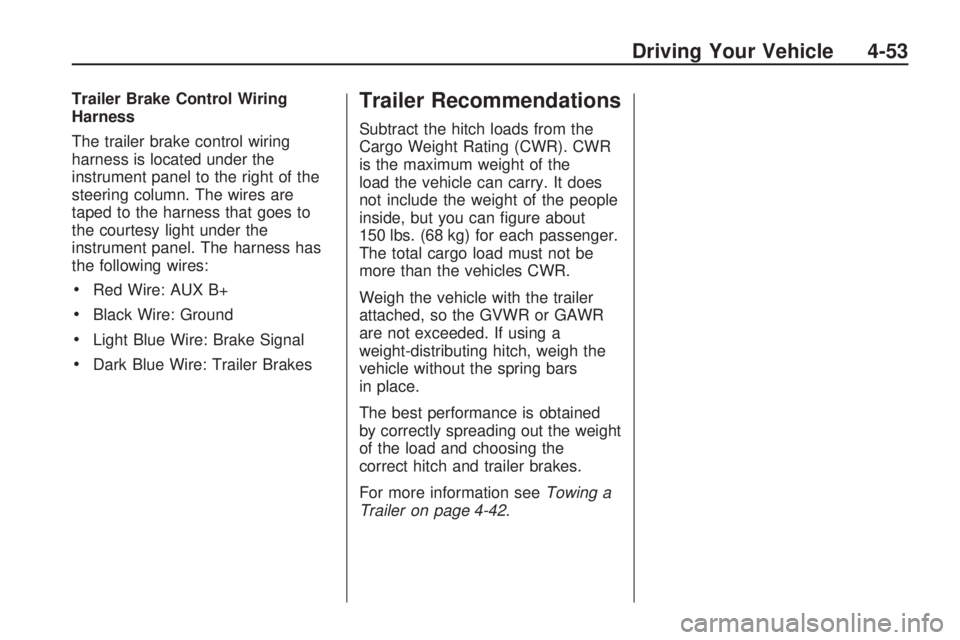
Trailer Brake Control Wiring
Harness
The trailer brake control wiring
harness is located under the
instrument panel to the right of the
steering column. The wires are
taped to the harness that goes to
the courtesy light under the
instrument panel. The harness has
the following wires:
Red Wire: AUX B+
Black Wire: Ground
Light Blue Wire: Brake Signal
Dark Blue Wire: Trailer Brakes
Trailer Recommendations
Subtract the hitch loads from the
Cargo Weight Rating (CWR). CWR
is the maximum weight of the
load the vehicle can carry. It does
not include the weight of the people
inside, but you can �gure about
150 lbs. (68 kg) for each passenger.
The total cargo load must not be
more than the vehicles CWR.
Weigh the vehicle with the trailer
attached, so the GVWR or GAWR
are not exceeded. If using a
weight-distributing hitch, weigh the
vehicle without the spring bars
in place.
The best performance is obtained
by correctly spreading out the weight
of the load and choosing the
correct hitch and trailer brakes.
For more information seeTowing a
Trailer on page 4-42.
Driving Your Vehicle 4-53
Page 236 of 382
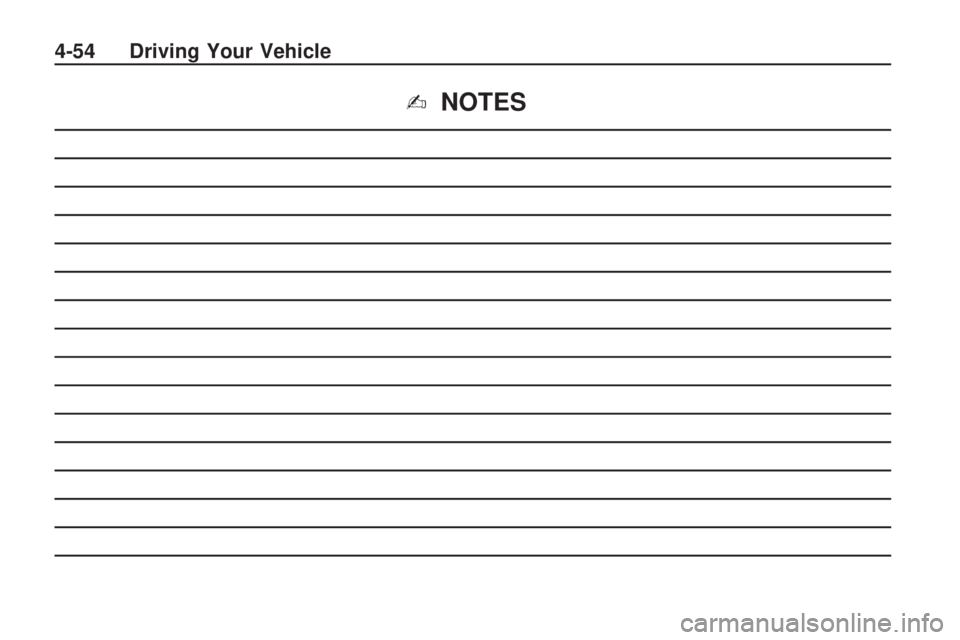
✍NOTES
4-54 Driving Your Vehicle
Page 237 of 382
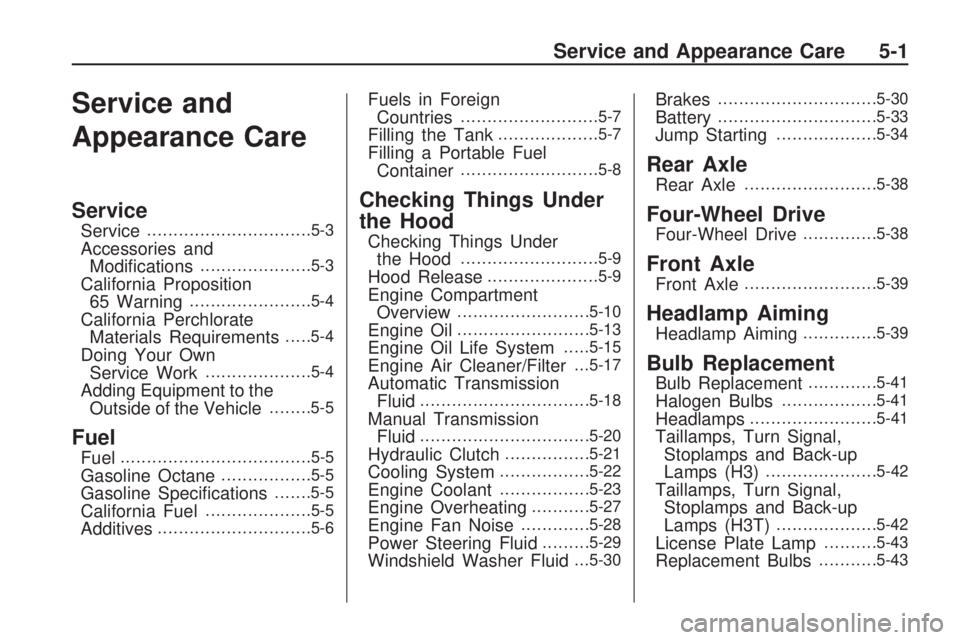
Service and
Appearance Care
Service
Service...............................5-3
Accessories and
Modi�cations.....................5-3
California Proposition
65 Warning.......................5-4
California Perchlorate
Materials Requirements.....5-4
Doing Your Own
Service Work....................5-4
Adding Equipment to the
Outside of the Vehicle........5-5
Fuel
Fuel....................................5-5
Gasoline Octane.................5-5
Gasoline Speci�cations.......5-5
California Fuel....................5-5
Additives.............................5-6
Fuels in Foreign
Countries..........................5-7
Filling the Tank...................5-7
Filling a Portable Fuel
Container..........................5-8
Checking Things Under
the Hood
Checking Things Under
the Hood..........................5-9
Hood Release.....................5-9
Engine Compartment
Overview.........................5-10
Engine Oil.........................5-13
Engine Oil Life System.....5-15
Engine Air Cleaner/Filter. . .5-17
Automatic Transmission
Fluid................................5-18
Manual Transmission
Fluid................................5-20
Hydraulic Clutch................5-21
Cooling System.................5-22
Engine Coolant.................5-23
Engine Overheating...........5-27
Engine Fan Noise.............5-28
Power Steering Fluid.........5-29
Windshield Washer Fluid. . .5-30
Brakes..............................5-30
Battery..............................5-33
Jump Starting...................5-34
Rear Axle
Rear Axle.........................5-38
Four-Wheel Drive
Four-Wheel Drive..............5-38
Front Axle
Front Axle.........................5-39
Headlamp Aiming
Headlamp Aiming..............5-39
Bulb Replacement
Bulb Replacement.............5-41
Halogen Bulbs..................5-41
Headlamps........................5-41
Taillamps, Turn Signal,
Stoplamps and Back-up
Lamps (H3)
.....................5-42
Taillamps, Turn Signal,
Stoplamps and Back-up
Lamps (H3T)
...................5-42
License Plate Lamp..........5-43
Replacement Bulbs...........5-43
Service and Appearance Care 5-1
Page 238 of 382
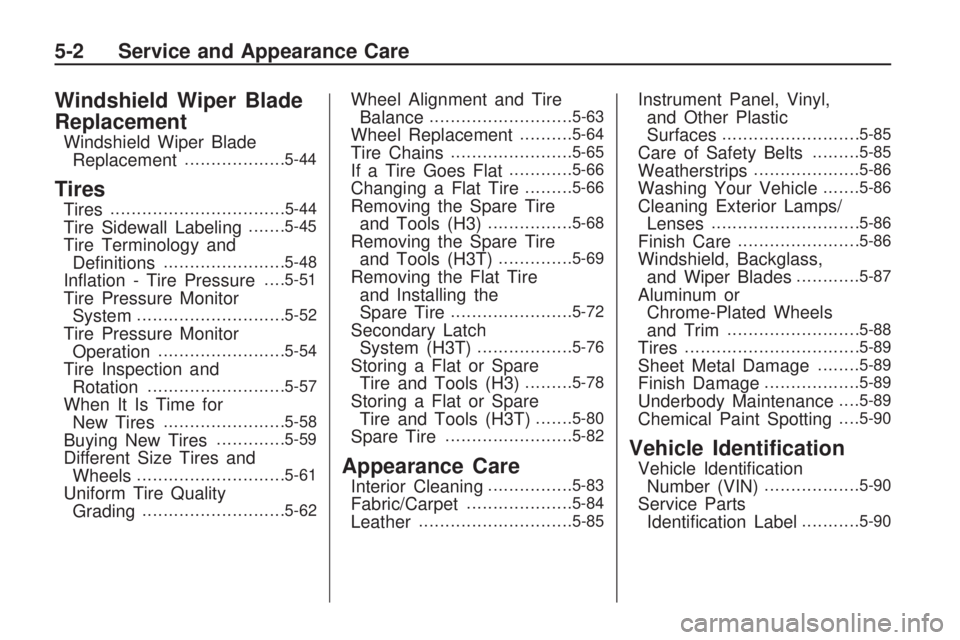
Windshield Wiper Blade
Replacement
Windshield Wiper Blade
Replacement...................5-44
Tires
Tires.................................5-44
Tire Sidewall Labeling.......5-45
Tire Terminology and
De�nitions.......................5-48
In�ation - Tire Pressure. . . .5-51
Tire Pressure Monitor
System............................5-52
Tire Pressure Monitor
Operation........................5-54
Tire Inspection and
Rotation..........................5-57
When It Is Time for
New Tires.......................5-58
Buying New Tires.............5-59
Different Size Tires and
Wheels............................5-61
Uniform Tire Quality
Grading...........................5-62
Wheel Alignment and Tire
Balance...........................5-63
Wheel Replacement..........5-64
Tire Chains.......................5-65
If a Tire Goes Flat............5-66
Changing a Flat Tire.........5-66
Removing the Spare Tire
and Tools (H3)................5-68
Removing the Spare Tire
and Tools (H3T)..............5-69
Removing the Flat Tire
and Installing the
Spare Tire
.......................5-72
Secondary Latch
System (H3T)..................5-76
Storing a Flat or Spare
Tire and Tools (H3).........5-78
Storing a Flat or Spare
Tire and Tools (H3T).......5-80
Spare Tire........................5-82
Appearance Care
Interior Cleaning................5-83
Fabric/Carpet....................5-84
Leather.............................5-85
Instrument Panel, Vinyl,
and Other Plastic
Surfaces
..........................5-85
Care of Safety Belts.........5-85
Weatherstrips....................5-86
Washing Your Vehicle.......5-86
Cleaning Exterior Lamps/
Lenses............................5-86
Finish Care.......................5-86
Windshield, Backglass,
and Wiper Blades............5-87
Aluminum or
Chrome-Plated Wheels
and Trim
.........................5-88
Tires.................................5-89
Sheet Metal Damage........5-89
Finish Damage..................5-89
Underbody Maintenance. . . .5-89
Chemical Paint Spotting. . . .5-90
Vehicle Identi�cation
Vehicle Identi�cation
Number (VIN)..................5-90
Service Parts
Identi�cation Label...........5-90
5-2 Service and Appearance Care
Page 239 of 382
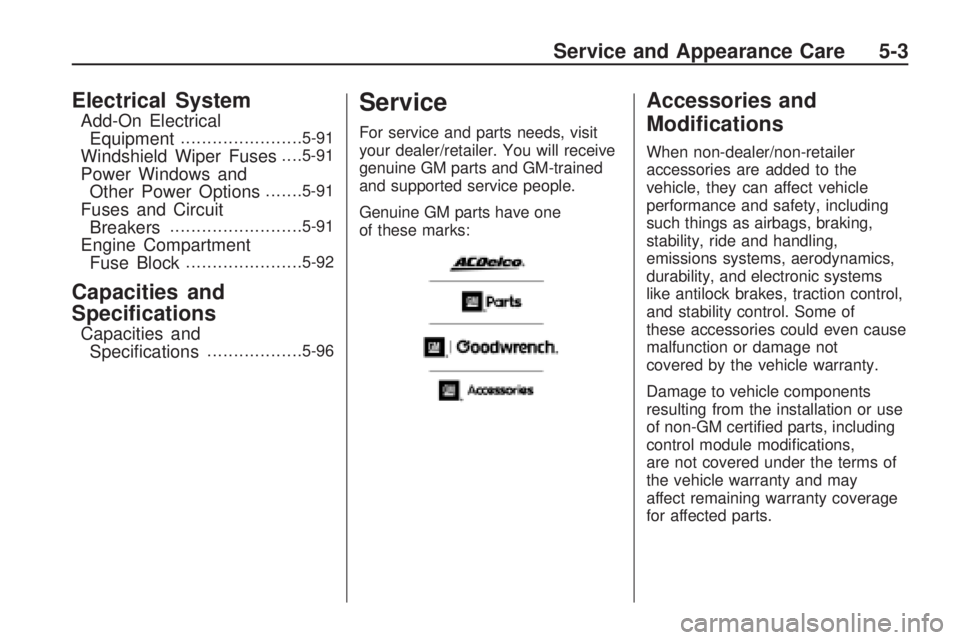
Electrical System
Add-On Electrical
Equipment.......................5-91
Windshield Wiper Fuses. . . .5-91
Power Windows and
Other Power Options.......5-91
Fuses and Circuit
Breakers.........................5-91
Engine Compartment
Fuse Block......................5-92
Capacities and
Speci�cations
Capacities and
Speci�cations..................5-96
Service
For service and parts needs, visit
your dealer/retailer. You will receive
genuine GM parts and GM-trained
and supported service people.
Genuine GM parts have one
of these marks:
Accessories and
Modi�cations
When non-dealer/non-retailer
accessories are added to the
vehicle, they can affect vehicle
performance and safety, including
such things as airbags, braking,
stability, ride and handling,
emissions systems, aerodynamics,
durability, and electronic systems
like antilock brakes, traction control,
and stability control. Some of
these accessories could even cause
malfunction or damage not
covered by the vehicle warranty.
Damage to vehicle components
resulting from the installation or use
of non-GM certi�ed parts, including
control module modi�cations,
are not covered under the terms of
the vehicle warranty and may
affect remaining warranty coverage
for affected parts.
Service and Appearance Care 5-3
Page 240 of 382
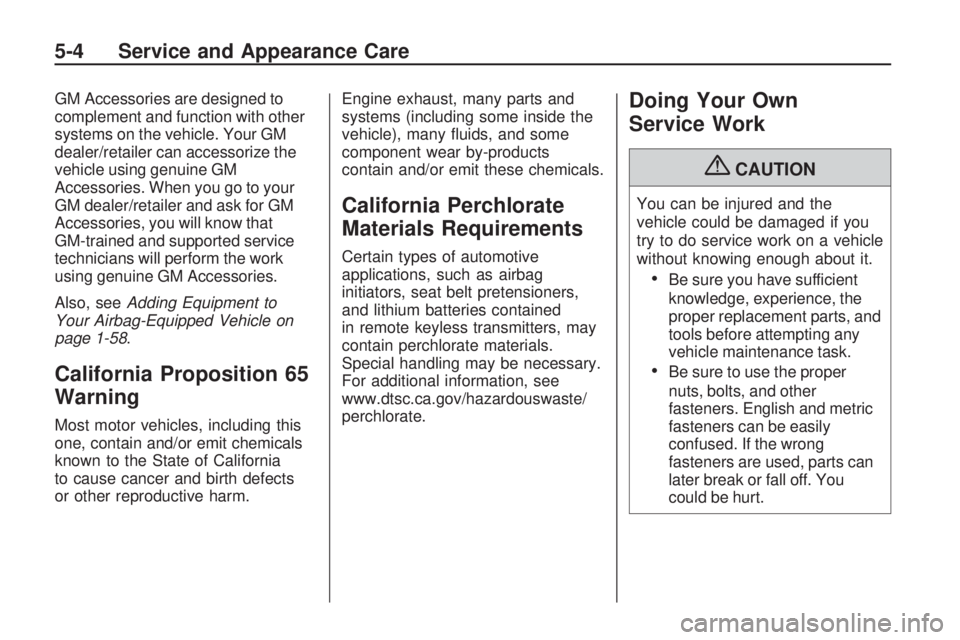
GM Accessories are designed to
complement and function with other
systems on the vehicle. Your GM
dealer/retailer can accessorize the
vehicle using genuine GM
Accessories. When you go to your
GM dealer/retailer and ask for GM
Accessories, you will know that
GM-trained and supported service
technicians will perform the work
using genuine GM Accessories.
Also, seeAdding Equipment to
Your Airbag-Equipped Vehicle on
page 1-58.
California Proposition 65
Warning
Most motor vehicles, including this
one, contain and/or emit chemicals
known to the State of California
to cause cancer and birth defects
or other reproductive harm.Engine exhaust, many parts and
systems (including some inside the
vehicle), many �uids, and some
component wear by-products
contain and/or emit these chemicals.
California Perchlorate
Materials Requirements
Certain types of automotive
applications, such as airbag
initiators, seat belt pretensioners,
and lithium batteries contained
in remote keyless transmitters, may
contain perchlorate materials.
Special handling may be necessary.
For additional information, see
www.dtsc.ca.gov/hazardouswaste/
perchlorate.
Doing Your Own
Service Work
{CAUTION
You can be injured and the
vehicle could be damaged if you
try to do service work on a vehicle
without knowing enough about it.
Be sure you have sufficient
knowledge, experience, the
proper replacement parts, and
tools before attempting any
vehicle maintenance task.
Be sure to use the proper
nuts, bolts, and other
fasteners. English and metric
fasteners can be easily
confused. If the wrong
fasteners are used, parts can
later break or fall off. You
could be hurt.
5-4 Service and Appearance Care